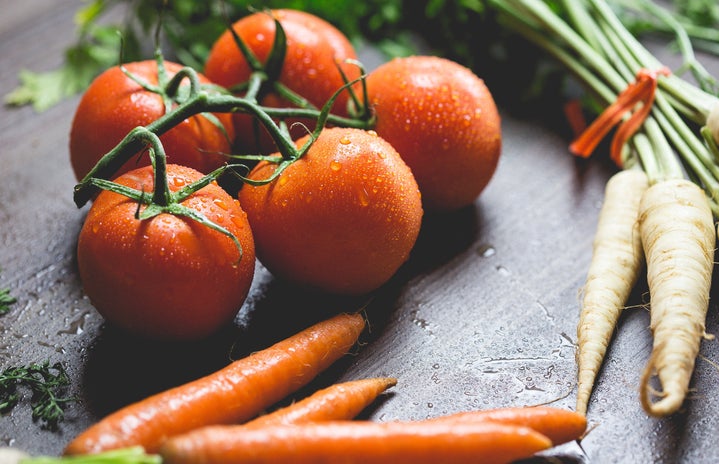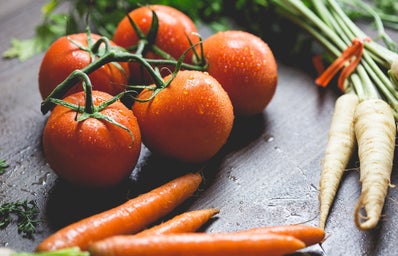Chocolate on the brain? Not surprising. Women (and men) have voted chocolate the most craved food. This semisweet cocoa delight made its way to the heart of a tug-of-war these past few years. “Health benefits!” news reporters chime excitedly when touching on new research results within the past decade. And every time, you say to yourself, “Chocolate? Really? It’s too good to be true.” A few paper cuts later, and Her Campus has returned from the library of heavy scientific journals with what you need to know… and it’s as juicy as a cherry cordial.
Calming Capacity
Chocolate’s reputation as girl’s best friend in terms of comfort food comes well-supported. Though it’s not quite considered a true aphrodisiac, phenylethylamine (PEA) in chocolate stimulates a euphoric feeling of falling love by releasing endorphins in the brain. Its carbohydrates also play a role to increase serotonin, also known as “the feel-good hormone.” Additionally, its aroma may affect theta brain wave to cause relaxation and reduce attentiveness, according to research findings at Middlesex University in the UK in 1996. So it’s not surprising that you reach for the King Size Hershey’s after a rough break-up or just a long day. But besides enhancing your mood, chocolate’s powers extend to the heart, skin, and your sweet tooth.
Heart-Healthy
Biting into a bar can increase the antioxidant levels in the blood. Antioxidants—a buzzword around many health foods—refers to a plant-based nutrient known for its ability to prevent heart disease, improve the immune system, and lower risk of cancer. Because chocolate comes from the cocoa bean (a plant), it reaps the benefits. A typical size bar of solid chocolate (1.5 ounces) can hold as many cancer-fighting antioxidants as a five-ounce glass of wine! Unprocessed cocoa powder ranked #1 on a list of the top antioxidant foods published in The Healing Powers of Chocolate, followed by the acai berry at #2 and dark chocolate at #3. Part of a trilogy that has been inducted into the One Spirit Book Club, a spirit and self-help book club, the book wraps the health benefits of chocolate with its history and more than 50 cocoa recipes. One particular antioxidant often appears in the same sentence as “dark chocolate” in studies of health benefits: flavonoids. For highest amounts of flavonoids, choose dark chocolates of 70% cocoa. In the heart alone, flavonoids work to protect against plaque formation on the arterial walls… And that’s just the beginning—read on to find out how they benefit your skin too.
Glowing Beauty
Rumors that chocolate puts pimples on your face are no more. Instead, German researchers at Heinrich-Heine University connected chocolate to smoother skin. After women ate a half-cup serving of flavonoid-enriched cocoa daily for three months, the ingested flavonoids helped protect the skin from exposure to UV rays and increased blood flow, making the skin appear healthier. Chocolate can offer benefits for the skin even without the calories. The powers of a chocolate spa bath impressed author Cal Orey the most in her research for her newest book, The Healing Powers of Chocolate, which published just last month. “The antioxidant benefits are supposed to make the skin softer and rejuvenate it like a natural facial,” she says.
Satisfying a Sweet Tooth
“If you deprive yourself of things you crave, down the road you’ll end up caving in,” says Katie Clark, registered dietician and assistant clinical professor at the University of California, San Francisco. “Buy chocolate in small sizes. Oftentimes, just a little will satisfy your craving.” Don’t let yourself get Hershey happy, though. While researchers at Pennsylvania State University in 2009 found that chocolate may not be addictive, stopping after serving one of two in a candy bar wrapper or a handful of Kisses still requires restraint. One more reason to go dark: the lower sugar content leaves for a slightly bittersweet, acquired taste—less tempting to go overboard. But are we to the point where nutritionists recommend eating chocolate every day? Clark votes no. Dark chocolate has a greater number of antioxidants, but that doesn’t mean it’s a “health” food per se.
…The Catch
Amazing as a health heart is, you can’t sidestep the fat and calories of chocolate. The dark chocolate Dove bar you eye in the candy slots of a checkout aisle contains 190 calories and 12 grams of fat in its 1.3 ounces. Munching on just two of these chocolate bars would require that you start saving 400 calories for your ‘health benefits.’ And in many cases, you need to consumer large quantities to see the perks. For the caloric cost, eating more chocolate may not equal gaining more benefits. More importantly, chocolate in its natural form is relatively high in saturated fat—the fat that raises your LDL, the bad cholesterol, Clark says. A high saturated fat diet can lead to heart disease, which counteracts any benefits won from flavonoids. To cut back on fat (and calories!) but still get antioxidants, try mixing cranberries in with your morning oatmeal. Now, before you run to the nearest convenient store (or perhaps even local chocolate factory) for your fix of this rich and creamy dessert, let me leave you with two pieces of advice:
- “Too much of a good thing is not a good thing,” Clark says. That’s why she recommends that we stick to the smaller, pre-packaged bite-size pieces—think dark chocolate Hershey Kisses or Dove squares. “It’s a similar concept to the hundred calorie pack,” she adds. Pre-packaged, there’s less temptation to continue eating (than, say, if you unwrapped a large bar of chocolate).
- Not all chocolate shares all the same health benefits. We’ve passed basic math, so remember these inequality equations when you’re looking for your perfect piece of pick-me-up: dark chocolate > milk chocolate > white chocolate. White chocolate contains no cocoa—no cocoa, no flavonoids, no cancer-fighting awesomeness. Oh, and stay away from hot cocoa mix; the production process depletes most mixes of the flavonoids.
Sources: Cal Orey, author of The Healing Powers of Chocolate (publish January 2010 by Kensington Publishing Corporation) Katie Clark, registered dietician and assistant clinical professor at the University of California, San Francisco American Dietetic Association. http://www.eatright.org/ Bruinsma, K. “Chocolate Food or Drug?” Journal of the American Dietetic Association. 99 (10): 1249-1256. 1999. Corwin, Rebecca. “Symposium Overview—Food Addiction: Fact or Fiction?” The Journal of Nutrition. 139 (3): 617-19. March 2009. DeNoon, Daniel J. “A Dark Chocolate a Day Keeps the Doctor Away: Daily dark chocolate good for the heart, loaded with flavonoids.” WebMD Health News. 2004.

